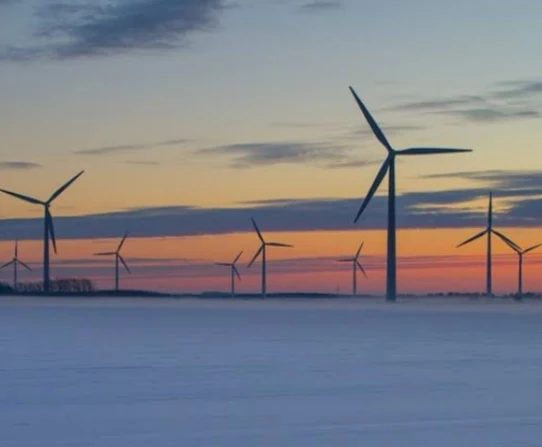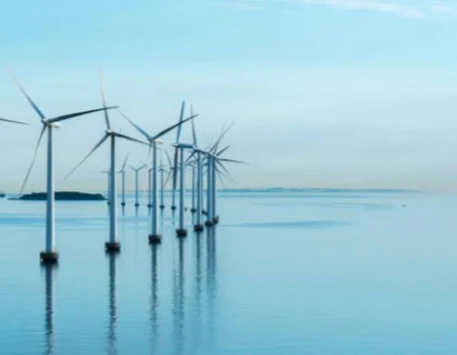Introduction Denmark Wind Energy Lansdcape
Denmark is a global leader in wind energy, boasting a landscape dotted with majestic turbines that harness the power of the North Sea and Baltic Sea winds.
From sprawling offshore wind farms to onshore wind parks nestled amidst rolling farmlands, these turbines are not just power generators, but also symbols of the country's commitment to clean and sustainable energy.
A Pioneer in Wind Energy:
Denmark's journey with wind energy began in the 1970s, driven by the oil crisis and a desire for energy independence. Since then, the country has invested heavily in wind power infrastructure, research, and development. This dedication has paid off handsomely, with Denmark now generating over 40% of its electricity from wind.
Onshore and Offshore Wind Farms:
Denmark's wind energy landscape is diverse, with both onshore and offshore wind farms playing a significant role. Onshore wind farms are typically smaller and scattered across the countryside, blending seamlessly with the agricultural landscape. Offshore wind farms, on the other hand, are massive installations located in the seas surrounding Denmark. These behemoths, with their towering turbines standing hundreds of feet tall, are a testament to human ingenuity and engineering prowess.
Harnessing Winds Across Land and Sea: Wind Farms Powering Denmark
Denmark's commitment to wind energy is evident in the diverse wind farms that dot its landscape, both onshore and offshore. These wind farms, ranging from pioneering installations to cutting-edge giants, collectively contribute significantly to the country's clean energy goals. Here are some notable examples:
Offshore Wind Farms:
- Horns Rev 3: Standing strong in the North Sea, Horns Rev 3 was the world's first offshore wind farm to utilize 4MW turbines. Its 49 turbines generate enough electricity to power approximately 400,000 homes.
- Anholt Offshore Wind Farm: Located in the Kattegat sea, Anholt is a true giant, boasting 111 Vestas 8MW turbines. It generates enough power for over 600,000 homes.
- Rødsand 2: Situated in the German Bight, Rødsand 2 features 90 Siemens Gamesa 6MW turbines, supplying clean energy to around 300,000 households.
- Middelgrunden: Uniquely situated in the Øresund strait between Denmark and Sweden, Middelgrunden's 20 Vestas V117 4MW turbines power approximately 50,000 homes.
- Samsø Offshore Wind Farm: This wind farm, located in the Kattegat sea, stands as a testament to Samsø island's commitment to sustainability. Its 10 Vestas V80 2MW turbines provide enough clean energy to make the entire island self-sufficient in renewable energy.
Onshore Wind Farms:
- Nysted Wind Farm: Looming over the Lolland island, Nysted boasts 72 Siemens Gamesa SWT-2.3-129 turbines, generating enough electricity to power around 340,000 homes.
- Fåvang: Nestled in the Midtjylland region, Fåvang features 28 Vestas V117 3.3MW turbines, supplying clean energy to over 63,000 homes.
- Horns Rev 1: A pioneer in offshore wind, Horns Rev 1's 80 Vestas V80 2MW turbines, though older, continue to contribute significantly to the grid, powering approximately 150,000 homes.
- Randbøl Hede: A sprawling onshore wind farm in Jutland, Randbøl Hede houses 62 Vestas V117 3.3MW turbines, generating clean electricity for over 137,000 homes.
- Kolding Nord: Located near Kolding city, Kolding Nord features 30 Siemens Gamesa SWT-2.3-116 turbines, providing clean energy to over 67,000 homes.
Continuous Expansion and Innovation:
Denmark's wind energy landscape is constantly evolving, with new wind farms being planned and constructed regularly. The country's dedication to wind power is unwavering, paving the way for a cleaner and more sustainable energy future.
Table of Wind Farms In Denmark
Denmark's Wind Power Landscape: A Glimpse at 10 Notable Wind Farms
| Wind Farm Name | Location | Type | Turbine Count | Capacity (MW) | Homes Powered | Image |
|---|---|---|---|---|---|---|
| Horns Rev 3 | North Sea | Offshore | 49 | 200 | 400,000 | |
| Anholt Offshore | Kattegat sea | Offshore | 111 | 876 | 600,000 | |
| Rødsand 2 | German Bight | Offshore | 90 | 540 | 300,000 | |
| Middelgrunden | Øresund strait | Offshore | 20 | 80 | 50,000 | |
| Samsø Offshore | Kattegat sea | Offshore | 10 | 20 | Entire island self-sufficient | |
| Nysted | Lolland island | Onshore | 72 | 237.6 | 340,000 | |
| Fåvang | Midtjylland region | Onshore | 28 | 92.4 | 63,000 | |
| Horns Rev 1 | North Sea | Offshore | 80 | 160 | 150,000 | |
| Randbøl Hede | Jutland | Onshore | 62 | 206.7 | 137,000 | |
| Kolding Nord | Near Kolding city | Onshore | 30 | 109.5 | 67,000 |
Note: This table includes only 10 examples for brevity. Many other impressive wind farms exist in Denmark.
Statistics of Denmark Wind Energy Lansdcape
Denmark's Wind Energy Landscape: Key Statistics
Denmark boasts a remarkable wind energy infrastructure, leading the world in several aspects. Here are some key statistics to paint a picture:
Installed Capacity:
- Total Wind Power Capacity: Over 8 GW (as of November 2023)
- Onshore Wind: Over 4 GW
- Offshore Wind: Over 4 GW
- Ranks No. 4 globally in total wind power capacity per capita
Generation and Consumption:
- Wind Energy Provides: Over 53% of Denmark's total electricity consumption (2022)
- Highest Month: February 2023, wind provided over 80% of electricity
- Record High Daily Production: 5.5 GW in February 2023
Turbines and Farms:
- Number of Wind Turbines: Over 6,200 (as of November 2023)
- Average Onshore Turbine Height: 130 meters
- Average Offshore Turbine Height: 200 meters
- No. of Offshore Wind Farms: 12 (operational and under construction)
- No. of Onshore Wind Farms: Estimated thousands
Economic and Environmental Impact:
- Jobs Created: Over 28,000 jobs directly and indirectly in the wind energy sector
- Greenhouse Gas Emissions Reduction: Around 20% reduction compared to 1990 levels
- Carbon Emissions Avoided: Over 4 million tons annually
Future Goals:
- Ambition to be carbon-neutral by 2050: Wind energy playing a central role
- Significant expansion of offshore wind capacity planned
- Innovation in grid integration and storage technologies
These statistics highlight the impressive achievements and ambitious future plans of Denmark's wind energy landscape. The country serves as a global model for clean energy transition and demonstrates the potential of wind power to contribute significantly to sustainable energy solutions.
Please note: These statistics are based on publicly available data as of January 2024. Specific figures may vary depending on the source and date of retrieval.
Table of Statistics Denmark Wind Energy Lansdcape
Denmark's Wind Energy Landscape: A Statistical Snapshot
| Statistic | Data | Image |
|---|---|---|
| Total Wind Power Capacity | Over 8 GW (as of November 2023) | |
| Onshore Wind | Over 4 GW | |
| Offshore Wind | Over 4 GW | |
| Global Ranking (per capita) | No. 4 | |
| Wind Energy in National Consumption | Over 53% (2022) | |
| Highest Monthly Wind Contribution | February 2023: 80%+ | |
| Record Daily Production | 5.5 GW (February 2023) | |
| Number of Wind Turbines | Over 6,200 (as of November 2023) | |
| Average Onshore Turbine Height | 130 meters | |
| Average Offshore Turbine Height | 200 meters | |
| Number of Offshore Wind Farms | 12 (operational and under construction) | |
| Estimated Number of Onshore Wind Farms | Thousands | |
| Jobs in Wind Energy Sector | Over 28,000 (direct and indirect) | |
| Greenhouse Gas Emissions Reduction | Around 20% compared to 1990 levels | |
| Annual Carbon Emissions Avoided | Over 4 million tons | |
| Carbon Neutrality Goal | 2050 | |
| Focus of Future Plans | Significant offshore wind capacity expansion, grid integration and storage innovation |
Challenges and Future Plans
Despite its success, Denmark's wind energy landscape faces challenges. Public acceptance and concerns about the visual impact of wind turbines can be hurdles to further development. Additionally, integrating large amounts of intermittent wind power into the grid can be complex.
However, Denmark remains undeterred. The country has ambitious plans to increase its wind energy capacity even further, with a goal of becoming carbon-neutral by 2050. This will involve building even larger and more efficient offshore wind farms, as well as exploring innovative solutions for storing and integrating wind power into the energy system.
Impact on the Environment:
Denmark's wind energy landscape has had a profound impact on the environment. By reducing reliance on fossil fuels, wind power has helped to cut greenhouse gas emissions and improve air quality. Additionally, wind farms provide habitat for marine life and can even boost tourism.
A Model for the World:
Denmark's success with wind energy serves as an inspiration for other countries seeking to transition to a clean energy future. The country's commitment to research, development, and public engagement has paved the way for the global adoption of wind power.
As the world grapples with the climate crisis, Denmark's wind energy landscape offers a glimpse into a possible future. A future powered by clean, renewable energy, where wind turbines stand tall as beacons of hope and progress.





